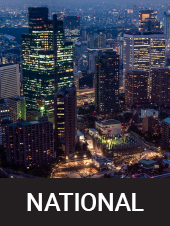Japanese Prime Minister Fumio Kishida canceled a planned trip to Central Asia on Friday to lead the government’s response after scientists urged people to prepare for a possible “megaquake” off the country’s southern coast.
The Japan Meteorological Agency issued its first ever “megaquake advisory” on Thursday warning of a possible future major earthquake triggered by the underwater Nankai Trough, after a magnitude 7.1 quake shook just off the eastern coast of Kyushu island earlier in the day. The trough, which runs along Japan’s Pacific coast, was the source of past devastating earthquakes.
Seismologists at the agency held an emergency meeting after Thursday’s quake to analyze whether it had affected the nearby trough and reassessed the risk of a major quake. They urged people to observe high caution levels for about a week.
Thursday’s quake injured 16 people, most of them slightly, and caused no major damage. Tsunami advisories were issued for several areas but lifted hours later.
Kishida announced that he had canceled his planned Aug. 9-12 trip to Kazakhstan, Uzbekistan and Mongolia as a result of the advisory.

“I have decided to stay in the country at least for about a week to make sure that government measures and communication are fully in place,” Kishida said.
The email you need for the day’s
top news stories from Canada and around the world.

Get daily National news
Get the day’s top news, political, economic, and current affairs headlines, delivered to your inbox once a day.
The Fire and Disaster Management Agency instructed 707 municipalities designated as at risk from a Nankai Trough quake to review their disaster response measures and evacuation plans.
The meteorological agency’s first “megaquake advisory” sparked public unease and prompted local government offices, rail operators and other agencies to begin introducing precautionary measures, affecting holiday travelers during the summer “Obon” holiday week.
Some municipalities even closed parks or cancelled events for the coming week, although officials and experts stressed that there was no need to shut down any normal activity. They said the advisory was aimed only at raising awareness of a increased probability over the long term, and that it was not for any specific timeframe or location.
Chief Cabinet Secretary Yoshimasa Hayashi called on people to carry on daily social and economic activities such as traveling.

Still, towns such as Higashi Osaka called on residents not to engage in “unnecessary and non-urgent” travel in case of a major quake. Other municipalities opened shelters, called on residents to stock up emergency food and water and to discuss evacuation plans among family members.
The popular seaside town of Shirahama in Wakayama prefecture said its four beaches, outdoor hot springs, parks and other facilities would be closed for the next week. An annual fireworks festival planned for Saturday was canceled.
Aoshima, another popular beach resort in Miyazaki prefecture, which was hardest hit by Thursday’s quake, also was closed.
Rail companies serving the region said their trains will operate at slightly reduced speeds as a precautionary measure.
In a 2013 report, a government disaster prevention team said that if a magnitude 9.1 quake struck near the southern coast, it could generate a tsunami exceeding 10 meters (33 feet) with a death toll of more than 300,000 and economic damage of more than 220 trillion yen ($1.5 trillion) in a worst case scenario.
© 2024 The Canadian Press





